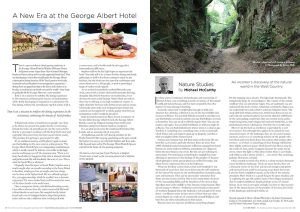
In three years of looking at the landscapes and countryside of Dorset, I have seen everything in terms of nature, of the natural world and natural beauty, and I’ve been inspired by that. But maybe I’ve been missing something.
Certainly, nature here is resplendent enough to hold your attention for a lifetime, as Dorset is one of the most wildlife-rich counties in Britain. You can find hillsides covered in cowslips; you can find hillsides covered in orchids; you can find hillsides covered in butterflies. You can see all six British reptiles here. You can see ospreys and eagles. You can find heathlands so wild you might be in Russia. You can find chalkstreams whose water is as clear as gin. Yet there is something else, something extra, in this countryside which I have only just begun to pick up on properly, and that is what you might call the human factor.
I mean, how humans have left their mark on the land. On one level this is, of course, perfectly obvious: there are more than 1,000 scheduled ancient monuments in Dorset ranging from burial barrows to stone circles to hillforts, and indeed, our village sits below the most famous one of all. But I’m not just referring to monuments. I’m referring to something less tangible but more affecting: to presences, to the feelings of the peoples of the past which perhaps in some special places can still be felt today; and where I have experienced this is in the holloways.
These are the deep sunken lanes, which over hundreds if not thousands of years have been worn down into the soft sandstone of the west of the county by the combined effect of people, cattle, carts and rainwater. They can be spectacular: sometimes their floors are now twenty or thirty feet or even more below the level of the surrounding fields, and the branches of the trees at their top edges meet in the middle so they become virtual tunnels. They are not unique to Dorset—holloways can be found in many parts of southern England where the bedrock is soft enough to be worn down—yet Dorset seems to have more of them than any other county, largely in a wide arc of countryside around Bridport, and here they are often extraordinary in their nature.
Because once you step into a holloway, everything changes. It’s like stepping into a church. The light fades dramatically. The temperature drops by several degrees. The sounds of the outside world are shut out and silence reigns. You are underneath: you are underneath the roots of trees, which take on fantastic shapes, you are underneath the wind, which is a distant, forgotten force. The steep cliff-walls which enclose you, which bear down on you on each side, are covered in plants, but not the cheerful wild flowers of the surrounding countryside: they are covered in ivy, and in shade-loving ferns, hart’s tongue fern and soft shield fern, so the predominant colour is dark green. The blue sky is worlds away.
Most of all, the hush in a holloway is pervaded by a sort of tenseness. For although they appear to be natural (if very unusual) features of the landscape, they are of course human artefacts, and it is as if something remains of the people who trod them and wore them down for century after century after century—as if there is something of their feelings still held in these tightly enclosed spaces which hasn’t been blown away by the winds of time, partly I suppose because the winds are up above, where the light is. Here down below there is just shade, and stillness, and a silence which is… not sinister. But unsettling, perhaps. Resonant, certainly.
I have started to realise that there is a whole mystical literature about the Dorset landscape. There are many books, there are a thousand stories of ley lines and natural energies and ghosts and mystical beasts and I’m not going to go down that route: I am too firmly wedded to nature, as the title of this column proclaims. But I think it is a good thing to be open-minded, and in exploring the age-old sunken tracks, I have begun to perceive that to understand Dorset deeply, perhaps a love of natural history on its own is not quite enough; you have to take account also of the human factor, of the peoples of the past, who lived in this landscape and loved it before us.
Recently relocated to Dorset, Michael McCarthy is the former Environment Editor of The Independent. His books include Say Goodbye To The Cuckoo and The Moth Snowstorm: Nature and Joy.




